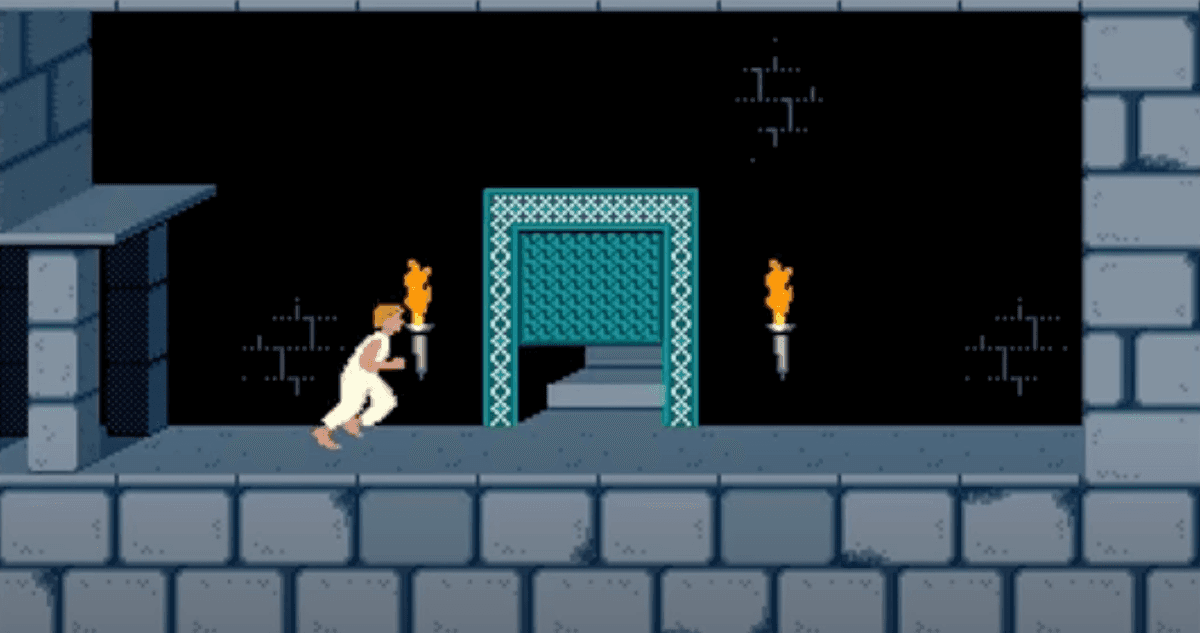The art of adding complexity without making things complicated


Before you stands a closed door. You’re boxed in by walls; torches flicker. No trapdoors or levers in sight. An awning offers the only hope.
You leap, grab the ledge, and…payoff. For the awning is a switch; grasp it and the door rises, revealing the path out of the dungeon and the solution to The Prince of Persia level one.
“A story doesn’t move forward until a character wants something,” game designer Jordan Mechner penned in his journal while developing the game. “So – a game doesn’t move forward until the player wants something.”
Like a child placing puzzle pieces until they find a fit, like a boulderer feeling their way to each toehold, the best games let intuition and curiosity guide players along. Walk, then run, jump, then climb. Here lies a sword; wield it, and its powers spark.
“Simple things should be simple, complex things should be possible,” said software design pioneer Alan Kay. The magic lies in revealing complexity, without feeling complicated, and without hampering the power users who already know the ropes.
The blank page problem
Simple is Notepad, open to a blank document, with no tools or buttons in sight. Simple is an email app, ready for you to add subscribers or to send messages, if only you knew where to start. Simple, far too often, makes everything possible, and so we freeze, unsure where to start.
Three years into The Prince of Persia’s development, Mechner was stuck at the same spot. “What makes a game fun? Tension/release, tension/release,” he decided the next day. But today, he was stuck in a dungeon of his own design.
“The way it is now, you’re plunged into a huge arena with no overall idea of what you’re trying to accomplish except ‘get out,’” he worried. “It’s too perplexing, especially at first.”
And so, brick by flaming torch, Mechner tweaked what originally felt like an aimless arena into levels that guided players into goals and subgoals. You’re rescuing a princess, in a 2D side-scroller, so the goal must be somewhere towards the right. Onward towards completion, until you hit an enemy, go back to discover a weapon, then defeat the enemy and progress. One could imagine a game with a way to skip earlier, training-focused levels, the way a Sudoku app lets you choose between easy and expert puzzles, but even still players need clues to guide them on. Good luck solving a puzzle without knowing the boundaries.
Software onboarding requires much the same progression. “Developers don't want to learn your API, they want to solve a problem and move on,” wrote Sebastian Bensusan. “As such, you should try to minimize the amount of learning they have to do.” And what goes for APIs goes even more so for software interfaces, with tools used by folks with a wide range of skill sets. An easy win, a mix of familiarity and a bit of easily learnable complexity, and users will come back for more.
Buttondown’s onboarding starts by asking your name (needed for your email’s From field, and to personalize your Buttondown experience), then asks if you're bringing in data from elsewhere (which, if so, it then shows you the import dialogue). Some complexity—account data, for instance—can’t be avoided. Others, like imports, can be hidden until needed.
Then, on to the dashboard, with a prominent New Email button guiding you towards the next step, and a Publish button on that screen. There’s little UI to learn, only solving the problem of sending an email to a list, and moving on. And with that, you’ve conquered Buttondown Level 1, never once having to stop to wonder where to go next.
Complex, not complicated
Strip everything down and you gain clarity at the expense of adventure. A game reduced to a single screen is hardly a game; just like an email newsletter app with a list of subscriber emails and a message body is little better than mail merge. Simplicity without depth leaves nothing to master.
For skills and accomplishment are what we crave. It’s not just that we want to send an email newsletter today, it’s that we want to feel like we did it a bit better than last time.
“There need to be sub-goals,” Mechner decided. “Places where you can say ‘Whew! Did it!” You don’t want a clear path to the exit, but also don’t want aimless wandering. You want the tension of the unknown, a few clues to lure you towards the solution, tempered with enough danger to cause an injury that teaches you what to avoid next time. Hard, but solvable, problems.
You might want to just send your first email newsletter today, when you create your Buttondown account. But by issue 5, you’ll be wondering if that’s all there is and might start looking around at alternatives if you can’t take your email newsletter sending skills further.
Showing every possible command in tabs and toolbars, Adobe and Office style, is complicated complexity, the opposite of the blank page problem where there’s too many options and no clarity in which action to take. The gaming solution is to slowly ramp up the challenge, introducing enemies that are slightly more difficult to beat that push you to discover new weapons and strategies, so when you encounter the boss you’re equipped to beat them. It’s continuous onboarding, one new feature at a time.
“They are learning by doing, but in a safe way,” as Chris Crawford wrote in The Art of Computer Game Design. Picking up a sword and facing your first enemy in Persia. Scheduling your newsletter for later, perhaps, in Buttondown, as you click around the Publish this email screen for the first time—where Buttondown includes optional scheduling options, canonical URLs, and notes to save details about that issue. Discovering features and commands via a search box that doubles as a command palette, as in Buttondown, where you can uncover Design options and dark mode while searching for subscribers whose name starts with d. Adding a subscriber via the API, and aha you have to add their email_address, that’s straightforward enough, and oh you could add a tag as well?
And complexity is unveiled, one accomplishment at a time.
Optimize for the easiest use case
Alan Kay’s maxim came from experience of building the Smalltalk programming language Xerox PARC. “The GUI had to be easily learnable by children,” said Kay, “but — looking ahead — it had to handle ’50,000 kinds of things we hadn’t thought of done by 50,000 programmers we hadn’t met’ and be as simple as possible.”
The only way to accomplish that is by unveiling complexity as needed.
Our challenge, at Buttondown, is to gradually unveil complexity as new cohorts and use cases reveal themselves. Our new dashboard pairs a checklist of completed tasks on your happy path (send your first email!) and side-quests (finish branding your newsletter). Our core editor shows little more than subscribers and emails; everything else is turned off by default, ready for users to uncover in Settings when they need more. Our API hides everything not yet needed; adding a subscriber requires merely POSTing { "email": "reader@example.com" }, no newsletter ID, subscriber status, or tags required. We’re optimizing for the easiest use case, with all of the extras available to discover when you want them.
Accomplishing more complex tasks—sending email newsletters with attachments to an audience segment via the API—is a bit more complicated, takes a bit longer to learn. But by adding one thing at a time, first sending a newsletter then sending to a segment then adding attachments and so on, as so many email newsletter senders do as their list matures, each skill will be learned along the way. You’ll gradually uncover complexity as needed, gaining the confidence to push on with all the easy wins under your belt.
We didn’t get there all at first; it takes a moment to add complexity, a lifetime to keep software from becoming complicated. “First ideas are never the best,” declared Mechner as he gazed into the abyss. It’s in the editing and refining that aimless arenas turn into that perfect balance of tension and release.
And 21 days after Mechner despaired of his game’s future, he handed the joystick to his colleague to see if he’d cracked the code.
Their verdict? “I feel like I’ve had an adventure.”